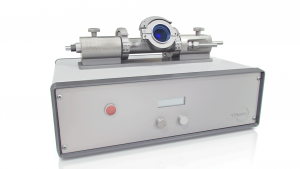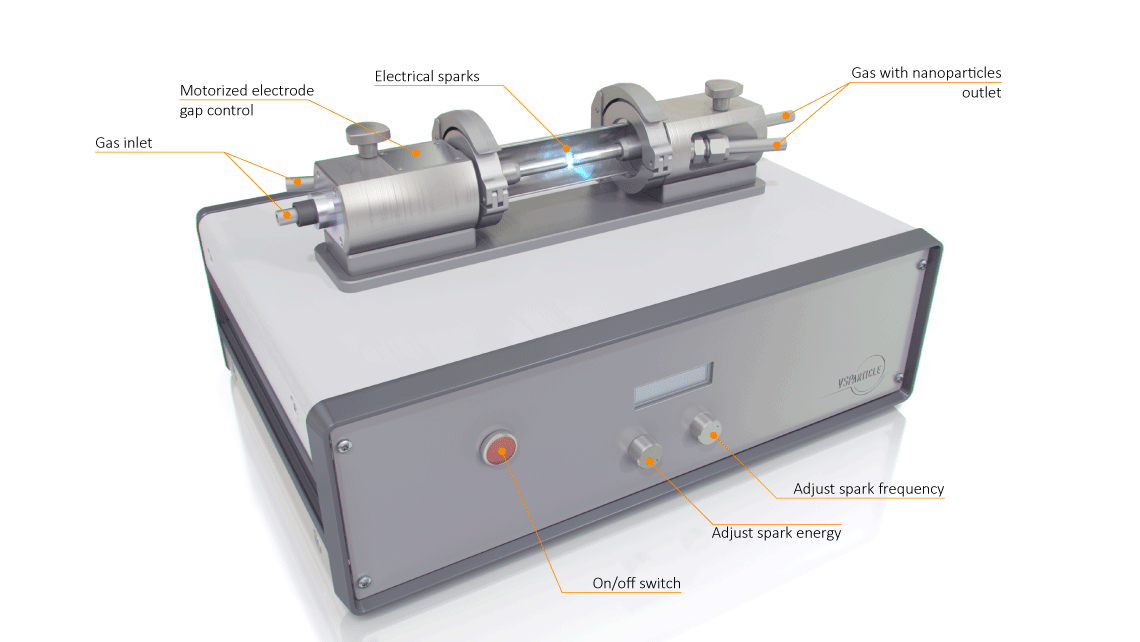VSP-G1 User Manual
This is the comprehensive User Manual for the VSParticle Generator One unit. The Quick Start Guide is available as a quick reference for standard operation of the G1 unit.

VSParticle
Molengraafssingel, 10
2629JD Delft
The Netherlands
info@vsparticle.com
www.vsparticle.com
Introduction to your system

The VSP-G1 is designed for researchers ("users") studying material properties who want to easily produce inorganic nanoparticles from conductive materials. Ease of use allows the user to control the size (1 atom to 20 nm) and production rate (xx – xx). The user can use different gases and electrode materials for a wider range of combinations, including the use of electrodes of different materials. The closed system and design of inner chamber results in high purity with no polymers near the ablation zone. Gas-based production eliminates the need for chemicals/surfactants or precursors. The reactor can easily be customized to allow cross flow, co-flow, through flow (standard) and combined configurations.
The production rate depends on the energy input into the spark, and material properties of the electrode. The VSP-G1 operates up to 60W, which corresponds to ablation rates up to ~100 mg/h for e.g. Au. Particle size is a function of the production rate and the flow rate. The spark gap is controlled automatically, allowing continuous operation. The spark generator is designed for a broad operating window, making it suitable for applications ranging from cluster research to materials science.
The closed system provides a safer production of nanoparticles and can easily be dismantled for safe transport of produced nanoparticles as well as for system cleaning and maintenance. Periodic cleaning and replacing of electrodes can be easily performed by the users with a safe, simple and fast (<20 mins) protocol.
The output of the system consists of a gas stream filled with particles, with no polluting by-products formed during production. The particles are made available as an aerosol, allowing the user to choose a suitable deposition method for his or her substrates. VSParticle can help select/develop a deposition system fitted to your specific needs.
The portability of the VSP-G1 system allows it to be integrated into a larger system for more complex operating procedures.
How to use this manual
This user manual provides instructions for the set-up, installation, operation and maintenance of a VSP-G1 unit. Before operating the VSP-G1 unit, please read the manual with careful attention to the safety section and to the warnings provided throughout the manual, indicated by the following symbols:
(symbols used in the manual)
| (Short index of manual and a 1 sentence summary of each chapter/section) |
A quick start guide is also included for faster set-up as part of the standard operating procedure. For more information regarding safety and more complex operations as well as troubleshooting and maintenance, please refer to this manual.
System and User safety
Working with nanoparticles
Warning of residual risks
Radiation (viewport, screen, UV)
Airborne noise emissions
Protective measures
Stability conditions
Foreseeable misuse
Unpacking your system
What's included in the box
- VSP-G1 Unit:
- etc
- etc
- Quick Start Guide
- EC Declaration of Conformity
- Warranty
Mount tool
Reactor
etc
Base unit
Cables
Setting up your system
Intended and unintended usage of the VSP-G1
Assembly, installation and connection

Stability conditions (warning box)
Electrodes
Operating your system
Standard procedure
Manual controls
Atypical situations
Making adjustments, conducting maintenance and carrying out preventive maintenance measures
Safety notes: safe adjustment and maintenance (including protective measures)
Caring for your system
Error messages and how to resolve them
Possible issues and how to resolve them
Maintenance protocols
Regular use
Periodic maintenance
When to contact VSParticle
Safe transportation, handling and storage
Accessories and Parts Replacement
Electrodes
Appendices
Theory/Background
Literature
Detailed communication set up
Remote controls
Connectors and pins
System technical specifications
EC Declaration of Conformity
Warranty
Edited by Kate Groves 11:13, 13 September 2016 (CEST)
